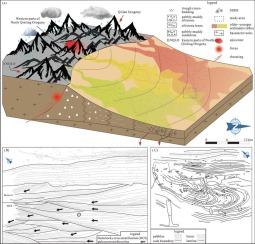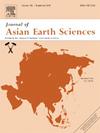地震诱发的冲积扇软沉积变形机制及其对鄂尔多斯盆地地质演化的启示
IF 2.4
3区 地球科学
Q2 GEOSCIENCES, MULTIDISCIPLINARY
引用次数: 0
摘要
暴露良好的软沉积变形构造(SSDS)露头非常罕见,经常被误认为是构造褶皱,导致沉积地质学的研究和利用受到限制。鄂尔多斯盆地中二叠统石河子组太童山剖面提供了对SSDS的研究,其空间分布和沉积揭示了古环境、构造运动和地震事件的信息,对了解盆地发育至关重要。本研究采用野外调查和沉积学的方法来研究固态污染物的形成和成因。野外鉴定出6个具有SSDS和同沉积构造的硅屑相。沉积学解释强调了地震活动与SSDS成因之间的联系,加强了它们在盆地演化研究中作为构造事件代表的价值。SSDS的形成是由地震震动触发的,引发液化、侵蚀、泥浆团块形成、水塑性变形、块状固结和岩化。在部分岩化的地下沉积物中,瑞利波诱发的液化形成了水逸出结构。物源分析表明,中二叠世北陆盆地西南、东南地区地震活跃,造山带源区隆起、侵蚀明显。重点发现,台桐山剖面中二叠统辫状河相起源于祁连造山带,其后物源向东-北秦岭造山带转移,突出了构造动力驱动物源快速转移,进一步塑造了沉积,推进了盆地演化。在此期间,北大陆架东南部的隆升速度比西南部更快。这些相沉积在一个推进冲积扇的远端扇区,在那里可能是由于NQLO的活跃地震活动而形成的震积岩。该研究确定了震积岩形成过程中的相间变化,引入了一种超越传统原位成因模型的创新概念,拓宽了对沉积动力学的理解。SSDS在沉积构造中的关键作用增强了对沉积地质学中盆地演化的理解,并为解释全球类似构造提供了一个框架。本文章由计算机程序翻译,如有差异,请以英文原文为准。

Seismically induced soft-sediment deformation in alluvial fans: mechanisms and implications for geological evolution of the Ordos Basin (China)
Well-exposed soft-sediment deformation structures (SSDS) outcrops are rare and often mistaken for tectonic folds, leading to limited research and underutilisation in sedimentary geology. The Taitongshan section of the Middle-Permian Shihezi Formation in the Ordos Basin, China, provides insights into SSDS, whose spatial distribution and sedimentation reveal information about paleoenvironments, tectonic movements, and seismic events crucial for understanding basin development. This study uses fieldwork and sedimentology to investigate SSDS formation and triggers. Fieldwork identified six siliciclastic facies with SSDS and associated syndepositional structures. Sedimentological interpretations highlighted the connection between seismic activity and the genesis of SSDS, reinforcing their value as proxies for tectonic events in basin evolution studies. SSDS formation is triggered by seismic shaking, initiating liquefaction, erosion, slurry-clump formation, hydroplastic deformation, mass consolidation, and lithification. Rayleigh waves-induced liquefaction in partially-lithified subsurface sediments forms water escape structures. Provenance analysis reveals seismically active, orogenic source areas southwest and southeast of the NCC, with significant uplift and erosion during the Middle-Permian. Key findings indicate that the Middle-Permian braided river facies of the Taitongshan section originated from the Qilian Orogenic Belt, followed by a subsequent provenance shift towards the eastern-North Qinling Orogeny (NQLO), highlighting the dynamic tectonic forces driving rapid provenance shifts, further shaping sediment deposition and advancing basin evolution. Furthermore, the southeastern NCC experienced a more rapid uplift than the southwestern part during that time. These facies were deposited on the distal fan region of a prograding alluvial fan, where seismites likely formed due to active seismicity in the NQLO. The study identifies inter-facies shifts during seismite formation, introducing an innovative concept beyond traditional in-situ genesis models and broadening the understanding of sedimentary dynamics. This critical role of SSDS in sedimentation architecture enhances the understanding of basin evolution in sedimentary geology and provides a framework for interpreting similar structures globally.
求助全文
通过发布文献求助,成功后即可免费获取论文全文。
去求助
来源期刊

Journal of Asian Earth Sciences
地学-地球科学综合
CiteScore
5.90
自引率
10.00%
发文量
324
审稿时长
71 days
期刊介绍:
Journal of Asian Earth Sciences has an open access mirror journal Journal of Asian Earth Sciences: X, sharing the same aims and scope, editorial team, submission system and rigorous peer review.
The Journal of Asian Earth Sciences is an international interdisciplinary journal devoted to all aspects of research related to the solid Earth Sciences of Asia. The Journal publishes high quality, peer-reviewed scientific papers on the regional geology, tectonics, geochemistry and geophysics of Asia. It will be devoted primarily to research papers but short communications relating to new developments of broad interest, reviews and book reviews will also be included. Papers must have international appeal and should present work of more than local significance.
The scope includes deep processes of the Asian continent and its adjacent oceans; seismology and earthquakes; orogeny, magmatism, metamorphism and volcanism; growth, deformation and destruction of the Asian crust; crust-mantle interaction; evolution of life (early life, biostratigraphy, biogeography and mass-extinction); fluids, fluxes and reservoirs of mineral and energy resources; surface processes (weathering, erosion, transport and deposition of sediments) and resulting geomorphology; and the response of the Earth to global climate change as viewed within the Asian continent and surrounding oceans.
 求助内容:
求助内容: 应助结果提醒方式:
应助结果提醒方式:


